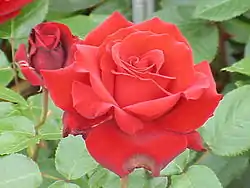薔薇
Chinese
| wild rose | Osmunda regalis | ||
|---|---|---|---|
| trad. (薔薇) | 薔 | 薇 | |
| simp. (蔷薇) | 蔷 | 薇 | |
Pronunciation
Derived terms
|
|
Descendants
Japanese
Etymology 1

| Kanji in this term | |
|---|---|
| 薔 | 薇 |
| Hyōgaiji | Hyōgaiji |
| Irregular | |
From 茨 (ibara, “bramble, briar”), itself an alteration from earlier reading ubara of the same meaning. The reading mubara appears in Heian period sources, but ubara is older.[1]
Noun
Usage notes
As with many terms that name organisms, this term is often spelled in katakana, especially in biological contexts, as バラ.
Derived terms
- 薔薇園 (baraen)
Etymology 2
| Kanji in this term | |
|---|---|
| 薔 | 薇 |
| しょう Hyōgaiji |
び Hyōgaiji |
| on’yomi | |
/sʲaubi/ → /ɕʲɔːbi/ → /ɕoːbi/
From Middle Chinese 薔薇 (MC d͡zɨɐŋ|ʃɨk̚ mˠiɪ|mʉi, literally “wild rose + kind of fern”).
Noun
薔薇 (hiragana しょうび, rōmaji shōbi, historical hiragana しやうび)
Usage notes
For the rose sense, the bara reading above is most common.
Etymology 3
| Kanji in this term | |
|---|---|
| 薔 | 薇 |
| そう Hyōgaiji |
び Hyōgaiji |
| on’yomi | |
/saubi/ → /sɔːbi/ → /soːbi/
Uses the goon reading of sō for the first character, and the kan'on reading of bi for the second character. Appears to be a shift in reading from shōbi above.[4]
Noun
Usage notes
For the rose sense, the bara reading above is most common.
References
- 1988, 国語大辞典(新装版) (Kokugo Dai Jiten, Revised Edition) (in Japanese), Tōkyō: Shogakukan
- 1998, NHK日本語発音アクセント辞典 (NHK Japanese Pronunciation Accent Dictionary) (in Japanese), Tōkyō: NHK, →ISBN
- 2006, 大辞林 (Daijirin), Third Edition (in Japanese), Tōkyō: Sanseidō, →ISBN
- 1997, 新明解国語辞典 (Shin Meikai Kokugo Jiten), Fifth Edition (in Japanese), Tōkyō: Sanseidō, →ISBN